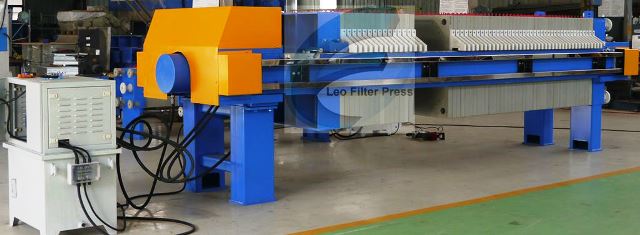Leo company's product prototype.

Plate and Frame Filter Press Working Principle for Plate and Frame Sludge Press Filtration from Leo Filter Press
Inquire or Request this information, Please E_mail: yankeeyang@vip.126.com
The plate and frame filter press comprises a series of filter plates and filter frames, which are arranged alternately, with a filter cloth or paper between them. The filter plates and filter frames are held together by a hydraulic or mechanical device, which applies pressure to the filter plates /filter frames and forces the suspension through the filter press cloth. The solids are trapped in the filter press cloth, while the filtrate passes through the cloth and all the filtrate will be in a receiver.
The working principle of the plate and frame filter press is simple, but it requires a complex set of operations to achieve effective filtration. The suspension is first fed into the filter press, and the filter plates are closed to form a series of chambers. The feed is then pumped into the chambers, and the pressure is applied to the filter plates and filter frames. The pressure forces the suspension through the filter cloth and the solids are trapped in the cloth.
The plate and frame filter press has several advantages over other filtration equipment, which makes it a popular choice in the industry. The first advantage is its ability to handle a wide range of suspensions with different particle sizes and shapes. The filter press cloth can be chosen based on the characteristics of the suspension, which ensures efficient filtration. The second advantage is its high filtration rate, which is achieved by the application of high pressure to the plates. The third advantage is its low operating cost, which is due to the low cost of the filter cloth and the simplicity of the equipment.
The plate and frame filter press has some limitations, which must be taken into account when selecting the equipment. The first limitation is the high labor requirement for operation and maintenance. The plates and frames must be cleaned and assembled after each filtration cycle, which requires a significant amount of time and effort. The second limitation is the high capital cost, which limits the use of the equipment in small-scale operations. The third limitation is the high energy consumption, which is required to apply the pressure to the plates.
Leo Filter Press Plate and Frame Filter Press Design and Operation Instructions:
Min. filter press order: 1 unit
Plate and frame filter press chamber capacity:1L to 2000L or based on OEM order
Plate and frame filter press hydraulic cylinder type: manual hydraulic J press hydraulic cylinder or automatic hydraulic pressing automatic hydraulic
Plate and frame filter press filter media: filter press cloth or filter paper
Plate and frame filter press feeding pump: many feeding pump for plate and filter press opration,such as diaphragm membrane pump,screw pump,piston pump,slurry pump
Plate and frame filter press chamber depth: 10mm to 50mm or based on OEM order
Plate and frame filter press filter plate and filter frame size: 500mm*500mm to 1000mm*1000mm or based on OEM order
The plate and frame filter press is an efficient and reliable filtration equipment, which is widely used in the industry. Its working principle is based on the filtration of suspension through a porous medium, and it requires a complex set of operations to achieve effective filtration. The equipment has several advantages, including its ability to handle a wide range of suspensions, its high filtration rate, and its low operating cost. However, it also has some limitations, including its high labor requirement, high capital cost, and high energy consumption.
 FilterPress.cc
FilterPress.cc Guestbook
Guestbook